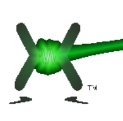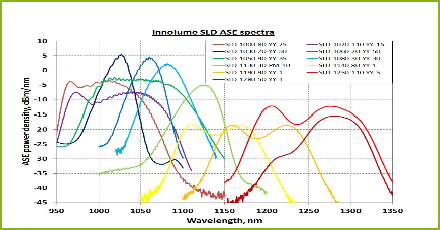SLEDs
A superluminescent light emitting diode is, similar to a laser diode, based on an electrically driven pn-junction that, when biased in forward direction, becomes optically active and generates amplified spontaneous emission over a wide range of wavelengths. The peak wavelength and the intensity of the SLD depend on the active material composition and on the injection current level. SLDs are designed to have high single pass amplification for the spontaneous emission generated along the waveguide but, unlike laser diodes, insufficient feedback to achieve lasing action. This is obtained very successfully through the joint action of a tilted waveguide and anti-reflection coated facets.
SLDs are optical sources with a rather wide optical bandwidth. In that they differ from both lasers, that have a very narrow spectrum, and white light sources, that exhibit a much larger spectral width. This characteristic mainly reflects itself in a low temporal coherence of the source (which is the limited capability of the emitted light wave to maintain the phase over time). SLDs may however exhibit a high degree of spatial coherence, meaning that they can be efficiently coupled into single-mode optical fibres. Some applications take advantage of the low temporal coherence of SLDs sources to achieve high spatial resolution in imaging techniques. The coherence length is a quantity frequently used to characterize the temporal coherence of the light source. It is related to the path difference between the two arms of an optical interferometer over which the light wave is still capable to generate an interference pattern.
On the one hand SLDs are semiconductor devices that are optimized to generate a large amount of amplified spontaneous emission (ASE). In order to do that, they incorporate high-power gain sections in which seeding spontaneous emission is amplified with high gain factors of 30 dB or more. On the other hand SLDs lack optical feedback, so that no laser action can occur. Optical feedback resulting from back-reflections of light from optical components such as e.g. connectors into the cavity is suppressed by means of tilting the facets relative to the waveguide, and can be suppressed further with anti-reflection coatings. The formation of resonator modes and thus pronounced structures in the optical spectrum and/or to spectral narrowing are avoided.
Applications
- OCT
- Non-invasive diagnosis
- Sensing in gas & oil production
- Telemetry in electricity distribution
- In-line production process monitoring,
- 3D metrology
- Surface metrology
- Semiconductor fabrication
- Chemical and gas sensing
- Intelligent distributed sensing
- Perimeter defence
- Navigation and guidance
- Gyroscopes
- Infrared illumination
- Speckle-free military imaging
- FTTx - gigabit bandwidth fibre link to homes and business
- Test & measurement















